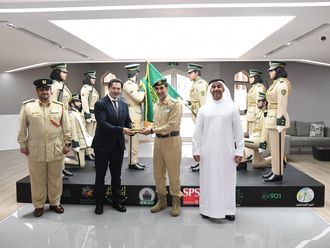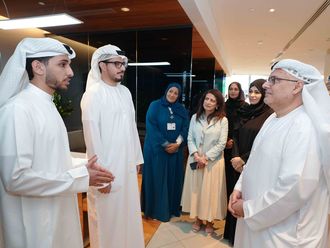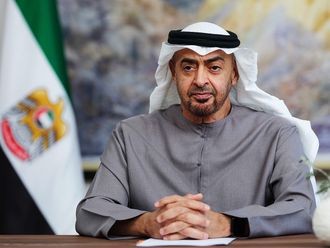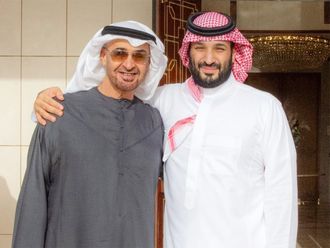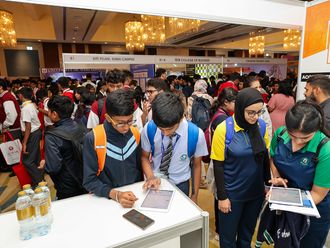A basic human instinct is the urge to win. In war or battle, politics or policy, profession or business, martial arts or mountaineering. An even greater urge is to celebrate victory. But Jay Sethuram, a U.S. citizen of Indian origin, recently in Dubai for a short holiday, is not satisfied with the design and development of the 32-bit microprocessor.
"Motivation, to me, is challenge – making trends and pursuing them," said the 40-plus IT professional, who is currently a partner and the Chief Technical Officer with Redwood Corporation, which is spawning new technologies that will have a profound impact on the evolution of the Internet.
A self-made technocrat, Sethuram was fired by the vision of a technologically advanced and prosperous society. Born and bred in Bangalore, he is the youngest in a family of seven siblings.
His fascination for electronics originated from his elder brother, who made a little crystal radio, but young Sethuram wanted to build a transisterised version of it. And he did assemble a radio in his teenage years. Pretty convinced that his ambitions were in that direction, Sethuram graduated in Electronics Engineering and proceeded towards the U.S. to do his masters, specialising in computer architecture.
He recalled his first assignment in the U.S. as a turning point, when he became acutely aware of the possibilities of applying technology to make life easier even in everyday activities, not to speak of high-tech applications.
Sethuram started his professional career at Bell Laboratories, which had produced many inventions including the transistor. Later, he worked on the architecture for the front-end processors for CAT scanners and MRI equipment, which have become vital life-saving tools for medical diagnosis.
He found the atmosphere in Bell Laboratories exhilarating. A lot of pioneering work was being done at Bell. The question persistently asked was how to better things. This quest for innovation was infectious and Sethuram too was caught up in it.
With the growing importance of the IT industry in the Silicon Valley, Sethuram moved to California where he joined the National Semiconductors and was engaged in the design of digital signal processors. Then he shifted focus to graphics and multimedia applications of personal computers, joining NEC America.
He enthused, "I was fascinated by the emerging trends in multimedia communication and the rapid strides in the field. I felt this presented enormous technological challenges in terms of data processing speed. The limitations of speed and cost could be overcome by developing suitable microprocessors and this drew me more and more into chip designing. Much of the equipment then in use was bulky and expensive, so I developed designs that would greatly reduce size and complexity, and thereby save costs while enhancing performance."
He admitted, "There were sceptics, of course, but the results were there for all to see." Seeking greener pastures, he moved to Intel to work on high-speed networking and this brought to light a new system. The realisation that dynamic new organisations are quick to exploit the full potential of new ideas led Sethuram to consider leaving a secure and well-paid job in a world-renowned organisation to pursue his own ideas.
He took the plunge and founded a partnership firm, Advancel and later Fiberlane, to develop designs for high-speed physical layer chips, and license the technology to semiconductor companies. The success of this venture attracted much attention among venture capitalists in the Silicon Valley and he secured funding from Kleiner, Perkins, Caulfield & Byers, the premier venture capital firm with which Vinod Khosla is associated.
Devoted to the design and development of equipment for fiber-optic communication, Fiberlane soon made a mark in this highly specialised field. With three locations in the U.S. and Canada, the firm rapidly grew in staff strength. Orders started pouring in at the rate of a million dollars per day. For logistic reasons the company was split into two entities – Cerent and Siara.
CISCO, the major customer for the company's products, soon realised that the technology spearheaded by Sethuram was vital for enhancing its own role in providing state-of-the-art networking equipment and it made the irresistible offer of $7 billion for acquiring Cerent, while Siara was acquired by Redback Systems for $5 billion.
But what kept Sethuram going in a foreign land? Admitting candidly, he said, "The challenge to work in this technology kept me going. To take off in a big way in the U.S. needed high speed communication and we wanted to sell into the market which was a very big one."
He said, "I have greatly benefited by being in the U.S. which has allowed me to rise to my full potential. The stimulating and competitive environment in this meritocracy make people contribute their best. This is particularly true in California, which attracts the best talents from all over the world. In America, only performance counts and everyone has a chance to do what one is good at. Ethnic background does not figure in this."
After such a winsome finale, how does he spend his time now? With commendable honesty, Sethuram agreed it is very boring to retire and sit in the house. "I spend more time with my family and try to keep myself fit by regularly playing tennis and jogging.
But my prime ambition now is to make other people successful by providing funds and sharing experienced ideas. All I have to say to my fellow Indians is to pursue their dreams, no matter how difficult the situation is. There is always light at the end of the tunnel and I strongly believe in it!"
Jay Sethuram - IT Professional
A basic human instinct is the urge to win. In war or battle, politics or policy, profession or business, martial arts or mountaineering. An even greater urge is to celebrate victory. But Jay Sethuram, a U.S. citizen of Indian origin, recently in Dubai for a short holiday, is not satisfied with the design and development of the 32-bit microprocessor.


